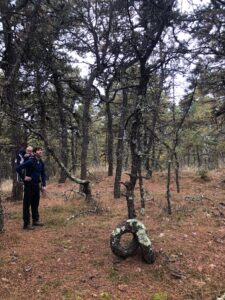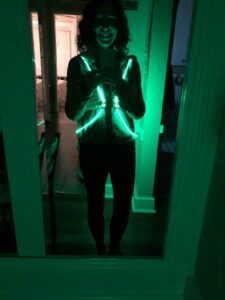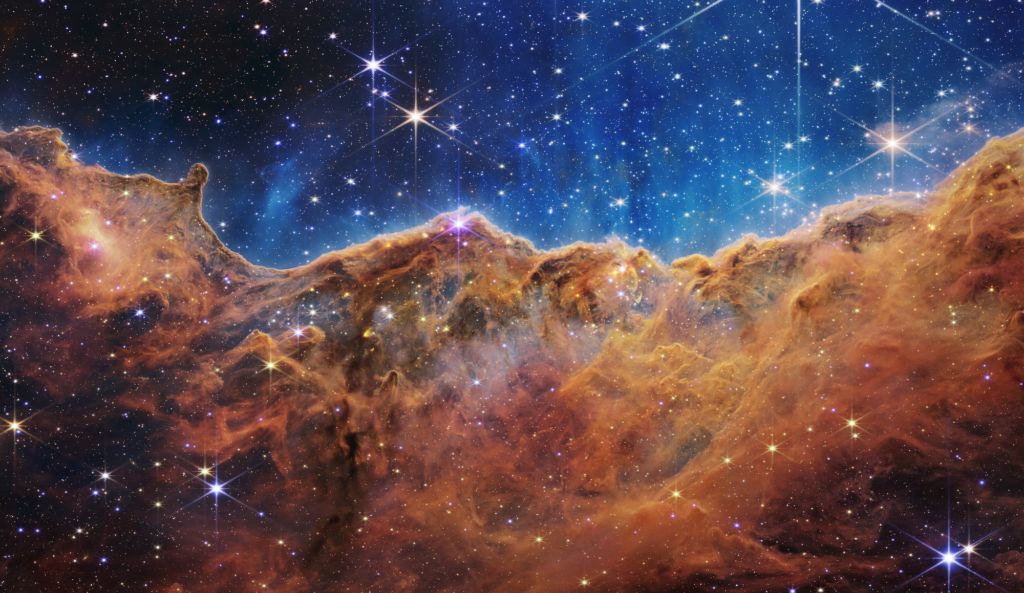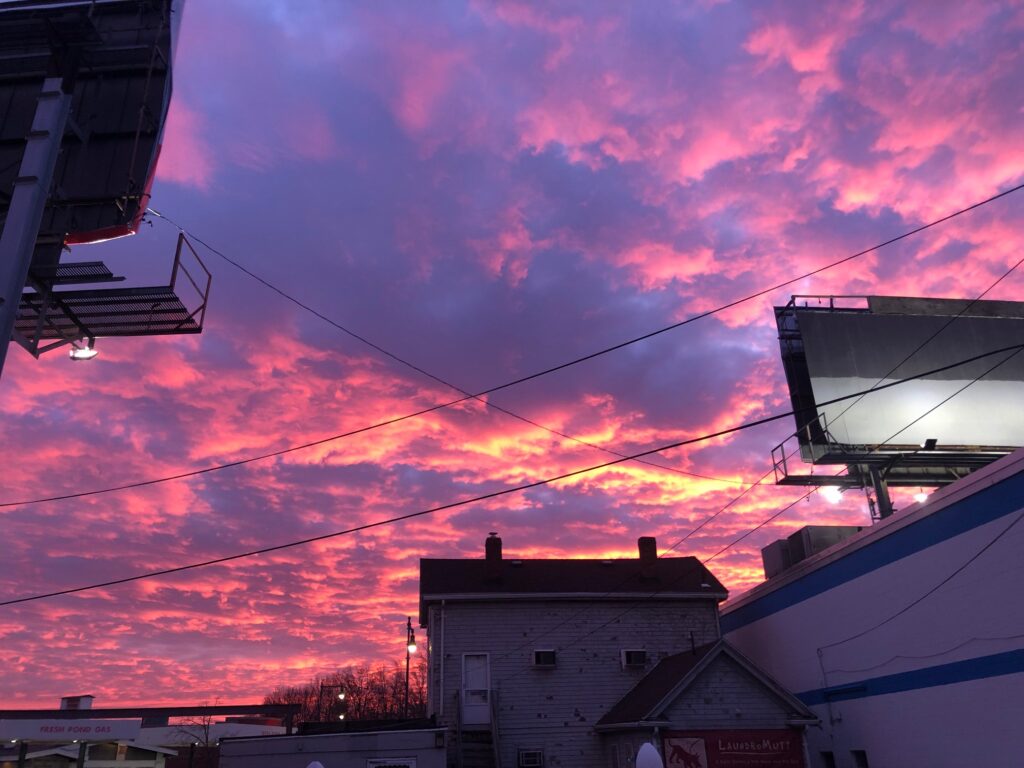Light and the way to it
Tavern
There is a ghost tavern for whalers on the far side of Wellfleet Bay, Cape Cod. Ghost because it’s so long gone I couldn’t find the excavated foundation promised by signs – but there was a sense among the forest of conifers evolved to withstand Foul Weather that Someone had Been Here, Long Ago. One tree grew in a circle, like a sea monster rising from the deep.

Who would stop for a drink and a bite to eat, maybe a warming fire, on a thin strip of land between the Atlantic Ocean and an overgrown tide pool?
Whalers, 1600s. Local legend tells that crews would wait there for quarry to swim into the bay. Then, at the call of a lookout (the era’s designated driver?), they’d shove off in small boats to hunt the trapped whales.
The ghost tavern doesn’t even have a name, at least not that I know of from hiking two miles to the site and back on a day threatening rain and evil imaginings.
How did they light the place, let alone the way to it?
Whale oil
Among relics found at the site: a pewter spoon, a wine bottle. Archaeologists who excavated the site in 1970 might have found a piece of a whale oil lamp, although it wasn’t listed on the signs. Considered high-tech at the time, a humble tavern in the woods probably wouldn’t have one, even when its primary customers were the men hunting the whales to provide oil to meet demand, eventually over-hunting them.
We finished our hike in a light rain. (Large, costly-looking homes set along the bay did not make the place look any less wild.) Then, as the rain turned into a storm, we visited the Sandwich Glass Museum, on the site of the former factory that had once produced the world’s best whale oil lamps.
In a display about indoor lighting, I saw approximately how dark it must have been in that Tavern for Whalers. With whale oil lamps beyond their means, they probably used smelly, smoky tallow candles. Cheaper, fossil fuel-burning kerosine lamps were 100+ years in the future. The nice bees wax candles I often imagine into the humble dwellings of colonial America were a luxury.
How did folks see at night even a few hundred years ago?
Short answer: they didn’t. The sun was the most powerful, reliable source of light. And these days, in late December, there isn’t much of it in New England.
Wreath
I’ve struggled to worship in the past six months. It’s not a spiritual problem, but a physical one. New to the Boston area and with a toddler in my care, it’s hard to get to a church. And once I do, I spend most of the service crawling on the floor.
The first Sunday in Advent, watching my son roll on the rug of a hallway/storage area that wonderfully also gave me a view of the alter and comprehension of most of the words in the sermon, I decided upon a plan of action for this season of anticipation, beginnings: I would catch a glimpse of the new advent candle each week. Anything else – singing, prayers, Psalm recitation, cookies after the service – was icing.
It was a good goal, quite tangible. I saw Advent wreath candles lit, one more each week, at four different churches this month. As the days grew shorter, the weekly ritual reminded me of the defiance of light, the refusal to let darkness take over when a tiny light is all you have.
Would a whaler waiting in a dark tavern be dazzled by the sight of just one candle?
Noxgear
Every week night, I walk a mile to pick Paul up from his daycare, leaving my home office at 5:05 p.m. This month, it’s completely dark by then. The traffic is a slow-moving river of light, red flowing one way, white the other.

To keep from getting flattened by a BMW in a crosswalk, I wear a battery-powered light vest. Marketed for winter running, Noxgear also works for stroller commuting. (“That’s a great light,” one weather-wizened bike-to-worker yelled to me last week as he zoomed by.)
I often set the light to friendly blue or festive green, but I can make it blink fierce red when I’m feeling extra defensive against the dark hulks of SUVs that wait for me to get into the crosswalk then blast their horns at me.
A crisscross of lighted tubes over my black puffer jacket does not make me invincible, I realize. It won’t repel steel. But knowing I’m lit up makes me feel, at this edge of urban wilderness, a little more powerful.
For the holiday season, I’ve added a string of colored lights to the stroller: $4.99 at CVS. I switch them on for Paul outside the KinderCare. See, light! He smiles sometimes, but at 17 months, he’s already underwhelmed by switches.
Two AA batteries and three AAA and voila: mother and child visible for 50 yards in the rain.
Did whalers hunt after dark?
Previously invisible
On Christmas 2021, NASA’s James Webb Space Telescope launched from Kourou, French Guinea in South America. For almost a month, it rocketed away, finally reaching a point in space one million miles from earth, where it is now orbiting the Sun. In July, the telescope, unfolded like an origami flower, sent its first images, views “the world has never seen before,” NASA said, announcing “the dawn of a new era in astronomy.”
These unbelievable constructions of light show things that previously lived only in or beyond imagination. The stuff of dreams, visions, the Book of Revelation are now labeled with a matter-of-fact authority:
“The edge of a nearby, young, star-forming region called NGC 3324 in the Carina Nebula. Captured in infrared light by NASA’s new James Webb Space Telescope, this image reveals for the first time previously invisible areas of star birth.”

Visible, yes, but mediated through a screen. I miss seeing stars directly, even a few, dimly. But I live in a city, and I am often too busy to look at the sky.
New England whalers found their way by the stars. Did they know what they were seeing? Did they care?
Do I?
Candlepower
In mid-December, I lit two candles on the dinner table. Pure fun, the candles lent a soft glow to the room.
Bill and I spoke at the same moment: “They’re so dim,” he said as I was saying, “They’re so bright.”
We were both right: two ways of looking at the same amount of light. He was thinking, I can’t imagine daily life with this little light. I was thinking, that tiny flame really does illuminate the room. Enough to read a few pages. Enough to see your food and light your way to bed. Enough to get by.
I love the way my eyes adjust to light. It’s midday now. Looking southwest out my window, my eyes are flooded, my pupils dialed down to pin pricks. Twelve hours ago, my pupils were open wide to gather in an annoying number of photons: the blinking light on Bill’s laptop, the neighbor’s flood light, the green dot on the ceiling smoke alarm casts an eerie two-foot wide circle on the bedroom floor. Stepping through it, late at night, I imagine it’s the portal between our world and another, one illuminated in green.
Capacity
Yesterday, walking through the dark evening to pick Paul up, I saw a crescent moon and Venus. The sky was clear, but all other objects were canceled out by the flickering lights of the Alewife T station and the never ending flow of automotive lava into and out of the city.
It reminded me of one night last summer, when, walking Paul in the stroller home from daycare I came upon a woman standing on the corner of Concord and Trader Joe’s. She was gazing up at…what was she looking at? A spectacular full moon? A sun shower? I can’t remember the celestial event, but I stopped to gaze at it, too. As we stood side by side, she said, “It’s a sign. Something good is about to happen.”
The human capacity for wonder is undiminished for those who choose to reach for it. While the 17th century whalers got to direct all of theirs toward the sky – a vast field of diamonds sparkling beyond their dim, damp daily lives – mine is split between those same stars, knowing, as we do, more about them than ever before even as they fade from sight, and the marvels of human innovation: my laptop, the internet, routine C-sections. Fresh fruit in Boston in the middle of winter.
Even battery-operated holiday lights. Paul laughed this morning when I turned them on.
